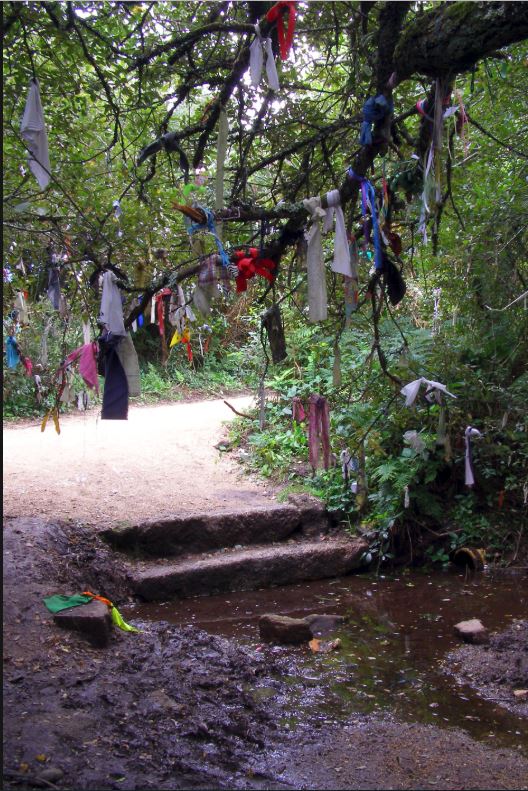In November, what started as an inquisitive peek down a rabbit hole turned into a weeks long meander thru a warren of interconnected themes. Reaching back into distant memory, which for me is anything beyond last week, I vaguely remember on another canoe forum, members taking issue with a real LNT keener who had removed a trailside memorial to a drowned paddler. I saw both sides of the debate, so I stashed this conundrum for future rumination. Likewise, I think I remember reading somewhere that Ojibwe hunters used to leave offerings hanging in trees to give thanks for a successful hunt. These were bones or a skull, often bear. Out of respect for first peoples, these and other signs and offerings should be left untouched. Bones in trees, tobacco ties, ribbon trees, and so on...
 carleton.ca
carleton.ca

 www.fitzhugh.ca
www.fitzhugh.ca

 en.wikipedia.org
en.wikipedia.org
Modern trail markers can be informative of the past.

 www.indigenousexperienceontario.ca
www.indigenousexperienceontario.ca
Back in my burrow I followed discussions concerning modern day misinterpretations regarding offerings of healing left hanging in trees next to holy wells in the Scottish Highlands.

 wildhunt.org
wildhunt.org
Pre-contact/colonial, and pre-Christian pagan belief systems from around the globe have many aspects of life and afterlife rituals in common. It can be more than a pragmatic way-finding tradition, marking a trail, it can also be a spiritual way of life tradition.
Quite frankly I blame HOOP for the genesis of this LNT pondering. In an excellent trip report he made years ago, he reflected on a pattern of stones in a stream. They were almost too perfectly aligned he reasoned, to be erratically natural, as they provided a channel through which he could float his loaded canoe past a shallow stony section. He questioned if these were ancient, from migrating first peoples, or perhaps a relic from the fur trade era, or maybe much more recent? And then the ethics of altering the landscape for modern convenience arose, for me in any case. He concluded that some marks on the land are humanly natural and acceptable, like cleared portages and stone fire rings. Although it's hard to draw a line somewhere in this sign vs scar, respect vs reckless, wild vs tame, sliding scale of virtue signaling, I for one decided less is more when I'm canoe tripping. A small fire ring of stones. A brushed trail with blazes or discreet signs. Even the luxury of a faint trail to a thunderbox. But any offerings I leave behind will soon fade, as sure as my footprints, in hopes that I and others can live on with that.
Tobacco Offering Protocol - Indigenous Gathering Site
Why and When to Offer Tobacco Offering tobacco in the form of a tobacco tie is a custom that is shared by many Indigenous peoples. Tobacco is offered for

Ribbon Trees - A traditional Indigenous practice - Fitz Hugh
Ribbon trees are much more than just pieces of fabric tied to trees. The ribbons and cloths are actually offerings back to the earth. Ribbon trees are appearing more frequently in Jasper National Park, placed by Indigenous communities that have historic ties to this landscape. Swatches of...

Trail trees - Wikipedia
Modern trail markers can be informative of the past.

Indigenous Trail Markers Across Ontario | Indigenous Experiences in Ontario
Indigenous Trail Markers Across Ontario Indigenous Trail Markers dotted across Ontario assist in honoring and bring testament and respect to Ontario's Indigenous peoples. These trail markers help visitors acknowledge the traditional territory of First Nation and Métis peoples. Markers...
Back in my burrow I followed discussions concerning modern day misinterpretations regarding offerings of healing left hanging in trees next to holy wells in the Scottish Highlands.

Clouties and “Cloutie pollution” - Europe, News, Paganism, U.K., U.S., World
Witchcraft & Pagan News - TWH looks at how the practice of using clouties made from non-biodegradable material negatively impacts the environment. | Europe, News, Paganism, U.K., U.S., World
 wildhunt.org
wildhunt.org
Pre-contact/colonial, and pre-Christian pagan belief systems from around the globe have many aspects of life and afterlife rituals in common. It can be more than a pragmatic way-finding tradition, marking a trail, it can also be a spiritual way of life tradition.
Quite frankly I blame HOOP for the genesis of this LNT pondering. In an excellent trip report he made years ago, he reflected on a pattern of stones in a stream. They were almost too perfectly aligned he reasoned, to be erratically natural, as they provided a channel through which he could float his loaded canoe past a shallow stony section. He questioned if these were ancient, from migrating first peoples, or perhaps a relic from the fur trade era, or maybe much more recent? And then the ethics of altering the landscape for modern convenience arose, for me in any case. He concluded that some marks on the land are humanly natural and acceptable, like cleared portages and stone fire rings. Although it's hard to draw a line somewhere in this sign vs scar, respect vs reckless, wild vs tame, sliding scale of virtue signaling, I for one decided less is more when I'm canoe tripping. A small fire ring of stones. A brushed trail with blazes or discreet signs. Even the luxury of a faint trail to a thunderbox. But any offerings I leave behind will soon fade, as sure as my footprints, in hopes that I and others can live on with that.
